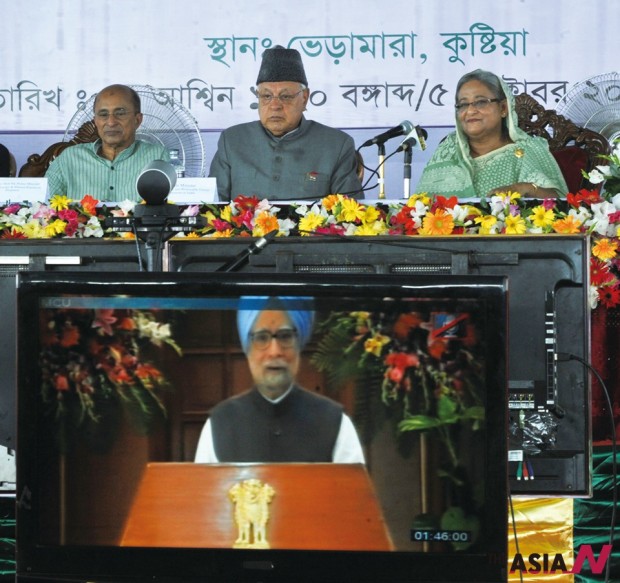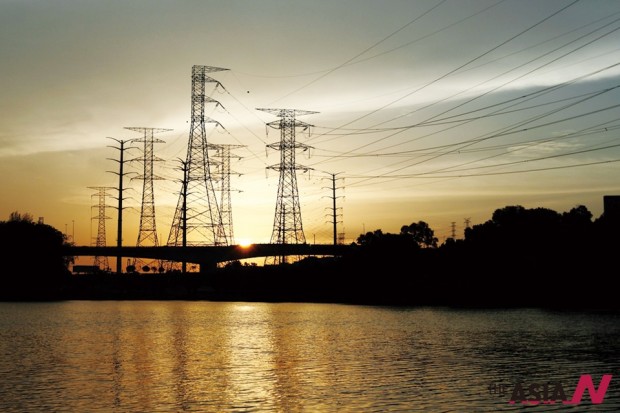Indo-Bangla power trading inaugurated

Indian Prime Minister Dr. Manmohan Singh delivers his inaugural speech through a videoconference as he along with Bangladesh PM Sheikh Hasina, right, inaugurated the Bangladesh-India Power Transmission Center at Bheramara in Bangladesh on October 5. Indian Minister for New and Renewable Energy Farooq Abdullah, center, is sitting beside Sheikh Hasina at the function. (Photo: BSS)
With the inauguration of the Bangladesh-India Power Transmission Center at Bheramara in the South-Western region of Bangladesh, the regional cooperation among the South Asian countries entered into a new era. The center was formally opened on October 5 and started supplying electricity produced in India to Bangladesh. Through this center, Bangladesh will get 500 megawatt (MW) electricity from India daily to meet the country’s demand for power. It is not only a step forward in overcoming the country’s power shortage, but it is another strengthening link between Bangladesh and India, the first South Asian countries to be trading electricity.
The South Asian Association for Regional Cooperation(SAARC) was established in December 1985 with the countries of the region aimed at promoting economic and social progress through cooperation among themselves. The SAARC group’s eight countries include Afghanistan, Bangladesh, Bhutan, Maldives, Nepal, Pakistan, Sri Lanka and India.
The SAARC, has already been implementing a number of development projects with cooperation among its member-countries. Since electricity is indispensable in the development process, the SAARC leaders have planned to set up a regional power grid to make electricity available for all countries.
However, much time has elapsed and the power grid plan remained unimplemented as all the SAARC member-countries faced shortages in power production. But, the scenario has been changing for the last several years as India, Nepal and Bhutan have developed their capacity to produce more electricity, especially hydro-electricity. Nepal and Bhutan, the two Himalayan countries, have developed enormous facilities to produce hydro-electricity and these two countries have already arranged for power transmission to India.
Bangladesh and India have reached an agreement for supplying electricity produced in India for Bangladesh through setting up a transmission center at Bheramara in Bangladesh territory. After the construction of the transmission center, India started supplying electricity formally from October 5. The formal supply was inaugurated by Bangladesh Prime Minister Sheikh Hasina at Bheramara while Indian Prime Minister Manmohan Singh joined the inaugural ceremony from his country’s capital New Delhi through a video conference.
As per the agreement, India would initially supply 500 MW everyday and the volume would be increased up to 1000 MW by next year. Bangladesh will pay India for the electricity at a rate fixed under the agreement and the price is almost the same as locally produced electricity in Bangladesh. Observers believe that Bangladesh is not losing by buying electricity from India since the country is getting power almost at the same price of local electricity without setting up a power generation plant at a huge cost.
Shortage of electricity remains as a chronic problem for Bangladesh since its demand for power continues to increase with the boosting of development activities. Bangladesh is now self-sufficient in food crops due to bumper production of rice every season for the last few years, and this bumper production was possible due to massive irrigation that required electricity. Therefore, Bangladesh needs huge quantities of electricity to cope with the growing industrial and agricultural development activities.
Bangladesh now produces around 6,000 MW electricity from the country’s 84 power generation stations. But, the country’s minimum total need of power is 7,000 MW per day, leaving a deficit of 1,000 MW. Such shortage affects economic growth as well as domestic life of the people. Now, the addition of 500 MW imported from India will undoubtedly improve the situation, yet a shortage will remain and that should be solved.
The government is constructing a few more power stations to generate more electricity, but it will take time.
So, import of power from neighboring countries is an easy and quick solution. Now, India has started exporting electricity to Bangladesh through a newly-established power transmission center at Bheramara, and the flow of electricity with this center will increase. It is expected that electricity produced in Nepal and Bhutan can also enter into Bangladesh through this supply line or through other transmission centers to be set up in the northern region of the country. Bangladesh has also been negotiating with another neighbor Myanmar to import electricity.
Step towards SAARC electricity grid
The opening of the Bangladesh-India Power Transmission Center at Bheramara is not only a significant step in the bilateral relations between Dhaka and New Delhi, but also a milestone in the process of setting up the much-awaited SAARC Power Grid, which would bring about much benefit for the people of South Asia.
Meanwhile, a process has been initiated to bring Pakistan and Sri Lanka under the proposed SAARC electricity grid. According to a report published recently in The Economic Times of New Delhi, the state-run Power Grid is preparing a road map for setting up an electricity grid to connect SAARC nations including Pakistan and Sri Lanka. The feasibility study for an undersea line with Sri Lanka is being finalized.
In its annual report for 2012~13, the Power Grid Corporation said it continues to play an active role in “preparing a road map for developing a SAARC market for electricity to develop a cross country power grid.” The proposed cross country grid is being envisaged for harnessing each SAARC nation’s capacities and resources to address growing needs in the region. India also plans to export electricity to Pakistan and discussions at government level are being held for interconnection between India and Pakistan, the report said.
The setting up of the SAARC Electricity Grid was an idea or a dream 28 years ago when the regional cooperation forum was established, but now the dream is at the doorstep of reality. And with the establishment of the Bangladesh-India Power Transmission Center, the process of its implementation has started.


























































